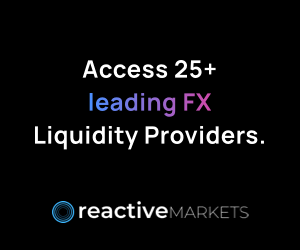How Difficult is it to Differentiate in Today’s FX World?
Posted by Colin Lambert. Last updated: November 29, 2023
The latest Voice of Experience from The Full FX, a series that taps into the knowledge of senior, and independent, FX market veterans, and invites them to discuss an issue in the FX industry that maybe others prefer to avoid, sees Ted Holloway ask…
How Difficult is it to Differentiate in Today’s FX World?
In my first article, penned a couple of months back, I asked whether liquidity was priced too cheaply? Following on from that, I wanted to discuss some of the key challenges I believe the FX, and in certain areas all markets are facing going forward. I stress these are purely my views, and I, but more importantly the editor, welcome any and all feedback.
The first challenge I want to discuss is reputational risk. In my view this is arguably the biggest risk facing LPs in today’s FX markets as they find themselves under constant scrutiny from compliance teams. Foreign exchange, as I am sure most would agree, is a highly-commoditised market, therefore distinguishing yourself from a highly competitive pack is tough. Traditional methods of doing so such as pricing, or the short-term view as I like to call it, are still employed, however, with ever-improving technology leading to greater margin compression, competition for every scrap of business has become very aggressive. It’s very tough, therefore, to make that distinction, let alone make any money.
I believe the onus is on providing clients with a service that enables individuals and institutions to distinguish themselves from the competition. In recent times, however, this has become increasing difficult, maybe almost impossible, due to reputational risk. Understanding markets, anticipating movements, and crucially being able to articulate these to clients is an art, and one that can distinguish an individual from the competition. As I alluded to earlier, however, it is a skill has almost been totally eradicated form today’s markets.
Reputational risk supersedes all. I wonder how many of you reading this article feel neutered when it comes to talking about the markets with your clients? All you can safely share these days is the “house” view. There were many occasions in my career when I did not share the “house” view. This required me to do my research in order to explain my rationale behind my view, and, crucially, it allowed me to be relevant to my clients, as it meant I wasn’t taking the one size fits all approach. Speaking to buy side contacts, this is something that they believe is missing in today’s markets.
At times I liken the FX market to a jigsaw puzzle, in that it’s very hard putting all the pieces together, but occasionally you get a glimpse of the bigger picture, and that’s what enables you to distinguish yourself from the competition. Having a well thought out and reasoned view should be encouraged.
Siloing
The second area I believe market participants can get better at is siloing. Immediately I can hear LP’s saying ‘we don’t have silos – that why FICC departments were set up’. In my experience working in a FICC team didn’t necessarily mean closer cooperation across each asset class. In most FICC teams I worked in the head often had either a bonds or Rates background, and currency experience was rare – as was information sharing.
If I asked FX participants their return on capital employed, I am not sure how many would know the answer
In such a highly competitive environment, where rewards can be high, this came as no surprise, however, as technology continues to eat away at margins – a trend that will only continue – to remain relevant and effective, working practices have to change. Those with the better understanding and relevant ideas are those more likely to win a greater share of client wallets, but gaining that information involves understanding the driving forces behind market moves. Often these can come from different asset classes outside of the one you are primarily focused on; some can, and often have been, trend setting when it comes to FX movements.
I have always felt that FX has been an undervalued asset class. The traditional valuation method has always been the bottom-line number, and naturally making a profit is paramount in any business, but the route via which that is achieved can, and does, vary.
FX is also an extremely capital light business. In the private equity space for example, return on capital employed is the key driver and all capital deployed is expected to reach a minimum benchmark return. If I asked FX participants their return on capital employed, I am not sure how many would know the answer. I am not talking VAR, rather I am asking the question of how much capital does an LP need to correctly service their clients, and what is their minimum benchmark return?
As a capital light business, returns in FX can be very attractive. Of course, durations tend to be a lot shorter than other asset classes, so this does present a challenge when attempting to accurately calculate returns, but in general by this measure I believe FX is under-valued.
As an FX structurer I set very clear targets on what my business needed to return on a capital employed basis. I used this as a requirement to evaluate clients within the portfolio and it was this that drove the P&L rather than simply just focusing on the bottom-line number of how much a deal was potentially going to make.
Evaluating whether a business product/client, is expected to achieve targeted return on capital employed is a much more efficient and compliant measure of value. Using this measure also had benefits when deploying capital. Some businesses are naturally more capital intensive than others, so FX’s contribution became all the more valuable when it came to assessing returns.
Siloing, however, particularly in commercial banks where the value of the balance sheet is often under estimated, meant this impact was often missed. I accept that, for some, this practice has been tightened up over the last few years, but when it comes to getting rewarded with a capital-light ancillary business such as FX, I would argue commercial banks are still leaving money on the table.
Breaking silo’s is tough, however in order to remain successful and relevant I believe it has to happen. Those that accept and adapt are those that are going to survive and succeed.
Thirdly, and probably the one most are talking about at the moment is artificial intelligence. There is no doubt that AI is going to speed things even further in not just the FX market, and no doubt it is already beginning to have an impact. A lot is being written about AI by those with far more knowledge of the subject than me, however, I think it’s safe to assume that AI is going to make the decision-making process a lot swifter.
Perhaps AI as well as challenging trading practices will change the way the market communicates?
Those that embrace AI and learn to adopt it where relevant in the FX market will hold an edge over those that don’t, or are slow to do so. Trading would potentially appear to be an area where the impact could and probably is, already being felt. I have read a number of articles that discuss the possible regulatory impact of AI trading. Whilst I am far from an expert, I suspect that any institution that adopts any form of AI trading will be subject to the regulatory rules that govern markets, and therefore expected to adhere to the FX Global Code. Failure to do so, or any malpractice would therefore reflect on the company for which it trades. Certainly the process of fixings could and probably would benefit from regulated AI.
On a lighter note, one thing I sincerely hope AI brings to end is the over-reliance on, and curse of, the Powerpoint presentation. Yes, I know AI is far more capable than that, but if, in some small way, it moves presentations in a wholly new direction, then I for one, will definitely welcome it!
Finally with the mention of Powerpoint, my fourth and final point highlights one of the key dependencies. Liquidity of course is paramount, as mentioned in my previous article, but speaking with buy side and banking contacts, most information, reference pricing and client to bank interaction, takes place across one platform. Whilst I have no problem with that platform, I do question whether having one dominant provider is a healthy situation for markets to find themselves in?
Perhaps AI as well as challenging trading practices will change the way the market communicates? I appreciate having a centralised information source makes things a lot easier from a regulatory point of view, but as I have highlighted earlier, nothing ever stands still in financial markets.
The only constant is change.




